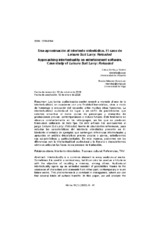Mostrar el registro sencillo del ítem
Una aproximación al intertexto videolúdico. El caso de Leisure Suit Larry: Reloaded
| dc.contributor.author | Botella Tejera, Carla | |
| dc.contributor.author | Méndez González, Ramón | |
| dc.date.accessioned | 2020-06-10T08:33:12Z | |
| dc.date.available | 2020-06-10T08:33:12Z | |
| dc.date.issued | 2020 | |
| dc.identifier.issn | 1579-9794 | |
| dc.identifier.uri | http://hdl.handle.net/10396/20146 | |
| dc.description.abstract | Los textos audiovisuales suelen recurrir a menudo al uso de la intertextualidad, en ocasiones con una finalidad humorística, otras a modo de homenaje o evocación del recuerdo, entre muchas otras funciones. La intertextualidad audiovisual da lugar a un sinfín de posibilidades que solemos encontrar al darse cruces de personajes y elementos de producciones previas, contemporáneas o incluso futuras. Este fenómeno se observa constantemente en los videojuegos, en los que se producen transvases culturales de todo tipo. En este artículo nos acercaremos al juego Leisure Suit Larry: Reloaded, fuente de abundantes referencias, para estudiar las características del intertexto videolúdico presente en él. Mediante el estudio de ejemplos que contengan referencias intertextuales y apoyados en análisis descriptivos previos propios y ajenos, estudiaremos sus características y particularidades. De esta manera, podremos ver las diferencias con la intertextualidad audiovisual y la literaria y descubriremos cómo se articulan las fases de su proceso de traducción. | es_ES |
| dc.description.abstract | Intertextuality is a common element in every audiovisual media. Sometimes it is used in a comical way, but it can also be used as a tribute or with the objective of recalling a memory, among others. Audiovisual intertextuality opens up an unlimited number of possibilities thanks to the crossover of characters and elements from other past, contemporary or even future works. This phenomenon is a constant in videogames, where we can find several kinds of cultural transfer. In this paper, we will analyze the videogame Leisure Suit Larry: Reloaded, as it has many references and it is a good case study to see which are the main characteristics of intertextuality in entertainment software. We will take several examples with intertextual references and, using previous descriptive analysis, we will study their main characteristics and their distinctive features. This way, we will be able to see the differences with intertextuality in audiovisual and literary works, and we will find out in which way the translation process is different from one media to another. | es_ES |
| dc.format.mimetype | application/pdf | es_ES |
| dc.language.iso | spa | es_ES |
| dc.publisher | UCOPress | es_ES |
| dc.rights | https://creativecommons.org/licenses/by-nc-nd/4.0/ | es_ES |
| dc.source | Hikma 19(1), 9-41 (2020) | es_ES |
| dc.subject | Intertexto videolúdico | es_ES |
| dc.subject | Trasvase cultural | es_ES |
| dc.subject | Referencias | es_ES |
| dc.subject | TAV | es_ES |
| dc.subject | Intertextuality | es_ES |
| dc.subject | Videogames | es_ES |
| dc.subject | Cultural transfer | es_ES |
| dc.subject | References | es_ES |
| dc.subject | Audiovisual translation | es_ES |
| dc.title | Una aproximación al intertexto videolúdico. El caso de Leisure Suit Larry: Reloaded | es_ES |
| dc.title.alternative | Approaching intertextuality on entertainment software. Case study of Leisure Suit Larry: Reloaded | es_ES |
| dc.type | info:eu-repo/semantics/article | es_ES |
| dc.relation.publisherversion | https://www.uco.es/ucopress/ojs/index.php/hikma/index | es_ES |
| dc.rights.accessRights | info:eu-repo/semantics/openAccess | es_ES |

